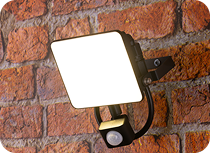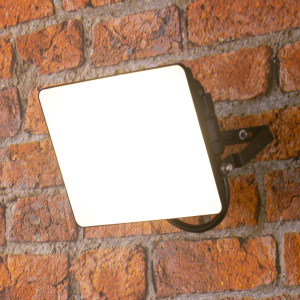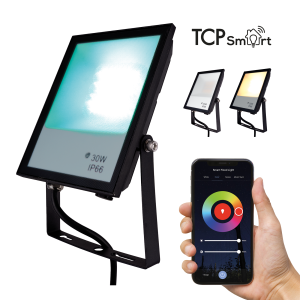Whether it’s securing your property, improving visibility at night, or highlighting key outdoor features, the right lighting makes all the difference. Floodlights provide a powerful and reliable way to illuminate spaces of all sizes, from small gardens to expansive industrial sites. But with so many types and features available, how do you choose the right one? This guide explores everything you need to know about floodlights, from their types and benefits to key considerations for making the best choice.
What are floodlights?
Floodlights are high-intensity, broad-beamed artificial lights designed to illuminate large outdoor areas with bright and uniform lighting. They are commonly used for security, sports venues, architectural highlighting, and outdoor workspaces, ensuring visibility in low-light conditions. Whether for residential, commercial, or industrial applications, floodlights enhance safety, deter intruders, and improve functionality in outdoor spaces.
Types of outdoor floodlights
Floodlights come in various types, each designed to suit different outdoor applications. Here are the main types of floodlights:
- LED Floodlights – Highly energy-efficient and long-lasting, LED floodlights consume less power while providing bright illumination. They generate minimal heat, require little maintenance, and are available in various wattages, making them ideal for both residential and commercial use. Their durability and weather resistance also make them a preferred choice for outdoor security lighting.
- Halogen Floodlights – Known for their bright white light, halogen floodlights are a traditional choice, often used for temporary lighting needs. However, they consume more energy and have a shorter lifespan compared to LEDs, making them less popular for modern applications. They also generate significant heat, which can be a disadvantage in some settings.
- Metal Halide Floodlights – These produce a high-intensity, bright white light with excellent colour rendering, making them suitable for large sports stadiums, car parks, and industrial areas where clear visibility is essential. However, they take longer to warm up, require regular maintenance, and are not as energy-efficient as LED alternatives.
- Solar Floodlights – Powered by solar panels, these floodlights store energy during the day and illuminate outdoor areas at night. They are eco-friendly, cost-effective in the long run, and ideal for gardens, pathways, and security lighting. However, their brightness depends on the amount of sunlight received, making them less effective in areas with limited sunlight.
- Motion Sensor Floodlights – Equipped with PIR (passive infrared) sensors, these lights automatically switch on when they detect movement, providing security without constant power consumption. They are commonly used around homes, driveways, and commercial properties to deter intruders and save energy by only activating when needed.
- Portable Floodlights – Designed for temporary lighting needs, these floodlights are battery-powered or rechargeable, making them ideal for construction sites, outdoor events, or emergency lighting situations. Their compact design and ease of transport allow for quick deployment in remote or off-grid locations.
Benefits of floodlights
Floodlights offer numerous benefits, making them a popular choice for outdoor lighting across residential, commercial, and industrial applications.
- Enhanced Security – Bright outdoor lighting helps deter intruders and improve surveillance, making floodlights an effective security measure for homes, businesses, and public spaces. Motion sensor floodlights further enhance security by activating only when movement is detected.
- Increased Visibility and Safety – Floodlights provide powerful, uniform illumination, reducing the risk of accidents in poorly lit areas. They are widely used in car parks, pathways, sports fields, and construction sites to improve safety for pedestrians and workers, especially when equipped with LED flood lights for enhanced visibility.
- Energy Efficiency – Modern LED floodlights consume significantly less electricity than traditional lighting options such as halogen or metal halide floodlights. This results in lower energy bills and a reduced carbon footprint while maintaining high brightness levels.
- Long Lifespan and Low Maintenance – LED and solar floodlights have an extended lifespan compared to traditional lighting solutions, reducing the frequency of replacements. Their durable design ensures they can withstand harsh weather conditions, minimising maintenance efforts and costs.
- Versatility and Customisation – Available in different wattages, beam angles, and colour temperatures, floodlights can be tailored to suit various applications. Whether for large-scale sports stadiums, residential gardens, or industrial workspaces, there is a suitable floodlight option for every need.
- Weather Resistance – Most floodlights are built with robust materials and high IP ratings, ensuring they can withstand rain, wind, and extreme temperatures. This makes them ideal for long-term outdoor use in different environments.
- Eco-Friendly Options – Solar-powered floodlights harness renewable energy, providing sustainable lighting solutions with no electricity costs. Additionally, LED floodlights generate less heat and contain no harmful substances, making them an environmentally friendly choice.
How to choose the right outdoor floodlight for your needs?
Choosing the right floodlight involves several key considerations to ensure optimal performance, energy efficiency, and durability. Here are the main factors to keep in mind:
- Brightness and Wattage – The brightness of a floodlight is measured in lumens, with higher lumens providing greater illumination. The required brightness depends on the size and purpose of the area—small residential spaces like gardens, driveways, and porches typically need 700 to 2,000 lumens, while medium-sized areas such as patios, pathways, and small warehouses may require 2,000 to 5,000 lumens. Larger commercial spaces, including construction sites and factory exteriors, benefit from 5,000 to 20,000 lumens, whereas sports fields and industrial sites often need 20,000 lumens or more. LED floodlights are the most energy-efficient choice, requiring significantly lower wattage than traditional halogen or metal halide options. For instance, a 10W LED floodlight produces around 1,000 lumens, while a 50W LED can deliver approximately 5,000 lumens, whereas halogen floodlights typically consume five times more power to achieve the same brightness.
- Type of Bulb – LED floodlights are the most energy-efficient and long-lasting option, while halogen and metal halide floodlights offer bright illumination but consume more power. Solar-powered floodlights are ideal for off-grid locations, though their brightness depends on sun exposure.
- Beam Angle – A wider beam angle (e.g., 120°) provides broad illumination, suitable for general security or area lighting. Narrower beam angles (e.g., 30°–60°) focus the light more precisely, making them ideal for accent lighting or illuminating specific features.
- Colour Temperature – Floodlights come in different colour temperatures, measured in Kelvin (K). Warmer lights (2700K–3500K) create a cosy ambience, while cool white (4000K–5000K) and daylight (5000K–6500K) offer brighter, clearer visibility, ideal for security and commercial applications.
- IP Rating (Ingress Protection) – Outdoor floodlights must withstand different weather conditions. Look for an IP65 or higher rating for full protection against rain, dust, and other environmental factors, ensuring longevity and reliable performance.
- Motion Sensors and Smart Features – If security is a priority, consider floodlights with motion sensors that automatically switch on when movement is detected. Smart floodlights with Wi-Fi or app controls allow remote adjustments and scheduling for added convenience.
- Energy Efficiency and Running Costs – LED floodlights consume less power and have lower running costs compared to halogen or metal halide options. Solar-powered floodlights offer even more savings by using renewable energy, eliminating electricity costs.
- Installation and Placement – Consider the height and positioning of the floodlight for optimal coverage. Wall-mounted floodlights work well for security, while pole-mounted or ground-fixed options may be better for gardens and large open areas.
- Durability and Build Quality – Ensure the floodlight is made of high-quality, weather-resistant materials such as aluminium or stainless steel. Shock-resistant and corrosion-proof designs are beneficial for long-term outdoor use.
By considering these factors, you can choose a floodlight that meets your specific needs, providing reliable, energy-efficient, and effective outdoor lighting.
Conclusion
Floodlights play a crucial role in improving outdoor lighting by offering security, efficiency, and versatility across different environments. By selecting the right type based on brightness, beam angle, and energy consumption, you can ensure optimal performance and long-term cost savings. Whether you need a floodlight for residential, commercial, or industrial use, modern options like LED and solar floodlights provide durable and eco-friendly solutions. Investing in the right floodlight enhances safety and functionality while reducing maintenance and energy costs.







